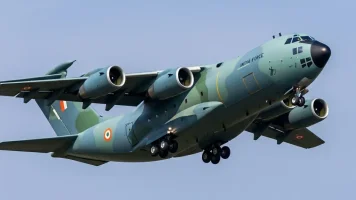- Views: 2K
- Replies: 13

Brazilian aerospace manufacturer Embraer has confirmed active discussions with the Indian Air Force (IAF) regarding the expansion of India's Airborne Early Warning and Control System (AEW&CS) capabilities, proposing its Praetor 600 business jet as the platform for the program's next phase.
This development comes as a strategic pivot following the cessation of production of the ERJ145, the aircraft currently underpinning India's Netra Mk1 AEW&CS.
The IAF currently operates three Netra Mk1 systems, developed indigenously by India's DRDO on Embraer ERJ145 platforms. These systems provide crucial real-time surveillance and command and control capabilities, playing a vital role in monitoring airspace and coordinating air operations.
The DRDO's Centre for Airborne Systems (CABS) is responsible for developing and integrating the radar and electronic warfare systems onto the chosen aircraft platform. The Netra Mk1 system was notably deployed during the 2019 Balakot airstrike, demonstrating its operational effectiveness.
Seeking to significantly enhance its airborne surveillance network, the IAF had initially planned to procure six additional ERJ145 platforms. However, with Embraer having ended production of the ERJ145 in 2020, transitioning its focus to the E-Jet family and the Praetor series, acquiring new airframes became unfeasible.
Sourcing used ERJ145s from the civilian market presented significant challenges related to availability, varying conditions, and the substantial costs associated with converting them for military use.
Embraer's proposal of the Praetor 600 offers a compelling alternative. Although a super mid-size business jet and smaller than the ERJ145, the Praetor 600 boasts several performance enhancements that could significantly bolster the IAF's AEW&CS capabilities.
Embraer claims the Praetor 600 offers nearly double the operational range of the ERJ145, extending the surveillance reach considerably. This increased range translates to longer loiter times, allowing for more extended monitoring of designated areas. The Praetor 600 also surpasses the ERJ145 with operational range, with 4,018 nautical miles (7,441 km) compared to 1,550 nautical miles (2,870km) of ERJ145.
Furthermore, the Praetor 600's higher service ceiling of 45,000 feet, compared to the ERJ145's 37,000 feet, could potentially enhance radar performance by allowing operations at altitudes where radar waves propagate more effectively.
Its maximum cruise speed of Mach 0.83, slightly exceeding that of the ERJ145, and its superior fuel capacity contribute to increased on-station endurance, enabling longer and more effective surveillance missions.
The Praetor 600, certified in 2019, features a full fly-by-wire flight control system, advanced avionics, and a modern, ergonomic cockpit. These features could potentially translate into reduced pilot workload and enhanced operational efficiency for the IAF.
Embraer's offer to supply six new Praetor 600s directly addresses the IAF's expansion needs while offering a technologically advanced and readily available platform. This proposal could not only fulfill the IAF's requirement for an expanded AEW&CS fleet but also introduce significant operational and technological advantages over relying on aging, repurposed aircraft.
The decision now rests with the Indian Ministry of Defence and the IAF, which will need to evaluate the Praetor 600's capabilities against operational requirements and budgetary considerations.
It may also consider alternative options, such as the previously proposed development of an AEW&C system based on the Airbus A319/320/321 platform, under the project named "Netra Mk2".


